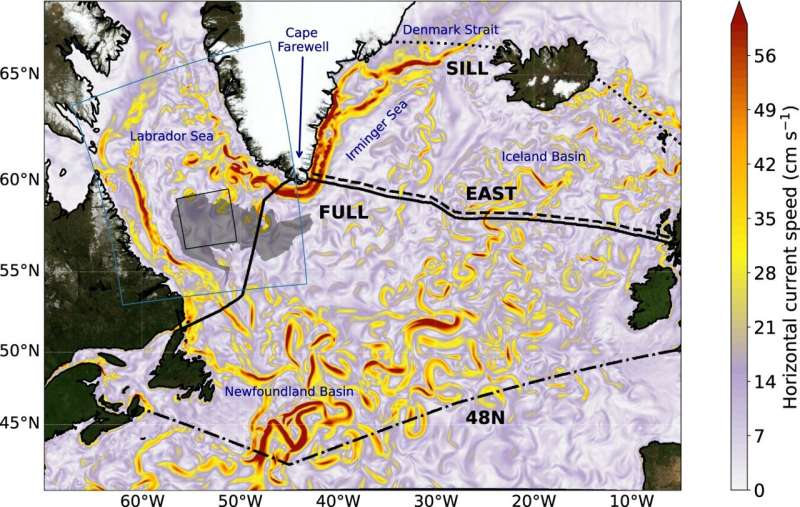This article has been reviewed according to Science X's editorial process and policies. Editors have highlighted the following attributes while ensuring the content's credibility:
fact-checked
peer-reviewed publication
trusted source
proofread
Winter storms over Labrador Sea influence Gulf Stream system

The Gulf Stream, which brings warm water from the Gulf of Mexico to Europe and keeps the climate mild, is only part of a larger system of oceanic currents called the Atlantic Meridional Overturning Circulation, or AMOC for short. It runs through the Atlantic like a giant climate machine: As warm water from the tropics is transported northwards at the surface, the current reverses in the North Atlantic—the water cools, becomes heavier and flows south at depth.
Where exactly these sinking processes take place is the subject of current research, and recent measurement programs have located them to the east of Greenland. A team of scientists from the GEOMAR Helmholtz Centre for Ocean Research in Kiel, Germany, has now conducted a modeling study focusing on the Labrador Sea southwest of Greenland. In their study, now published in the journal Nature Communications, the researchers used complex computer simulations to show that fluctuations in the Labrador Sea can have a significant influence on the strength of sinking processes east of Greenland. An important link is a little-noticed system of deep currents that ensures rapid spreading of Labrador Sea water into the deep-sea basin between Greenland and Iceland.
"We oceanographers have long had our eyes on the Labrador Sea between Canada and Greenland," says Professor Dr. Claus Böning, who led the study. "Winter storms with icy air cool the ocean temperatures to such an extent that the surface water becomes heavier than the water below. The result is deep winter mixing of the water column, whereby the volume and density of the resulting water mass can vary greatly from year to year."
In the model simulations of the past 60 years, the years 1990 to 1994 stood out, when the Labrador Sea cooled particularly strongly. "The unusually large volume of very dense Labrador Sea water that formed following extremely harsh winters led to significantly increased sinking between Greenland and Iceland in the following years," explains Dr. Böning. As a result, the model simulations calculated an increase in Atlantic overturning transport of more than 20%, peaking in the late 1990s. The measurements of the circulation in the North Atlantic, which have only been carried out continuously since 2004, would then fall exactly in the decay phase of the simulated transport maximum.
"According to our model results, the observed weakening of the Atlantic circulation during this period can therefore be interpreted, at least in part, as an aftereffect of the extreme Labrador Sea winters of the 1990s," summarizes Professor Dr. Arne Biastoch, head of the Ocean Dynamics Research Unit at GEOMAR and co-author of the study. However, he clarifies, "Although we cannot yet say whether a longer-term weakening of the overturning is already occurring, all climate models predict a weakening as a result of human-induced climate change as 'very likely' for the future."
Ongoing observing programs and further development of simulations are crucial for a better understanding of the key climate-relevant processes, as well as for future projections of the Gulf Stream system under climate change.
More information: C. W. Böning et al, Decadal changes in Atlantic overturning due to the excessive 1990s Labrador Sea convection, Nature Communications (2023). DOI: 10.1038/s41467-023-40323-9
Journal information: Nature Communications
Provided by Helmholtz Association of German Research Centres





















